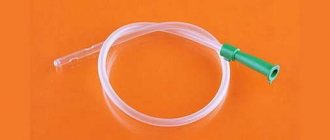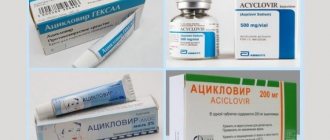Until three months of age, children adapt to a new type of diet and often suffer from digestive problems. About half of babies suffer from colic and increased gas production. Painful sensations lead to loss of appetite, sleep disturbances, and frequent crying. To make the baby's life easier, parents often use a gas outlet tube. In emergency cases, it helps empty the intestines and normalizes the baby’s condition. Among modern devices we can highlight the Windi pipe.
Main characteristics
Vapor tubes are far from new for parents. They started using the devices 3-4 decades ago, and have still not lost their popularity. The use of gas tubes for newborns is recommended for colic, prolonged constipation, and bloating.
Windies are devices tested by parents and have a number of advantages over domestic tubes. The shape of the device fully meets the characteristics of the child’s body and is completely safe for the baby.
Among the main characteristics of the device are:
- minimal risk for a small organism;
- the manufacturing material does not contain latex, which causes allergies;
- the dimensions of the device allow you to influence the muscle that prevents the escape of gases;
- There is a limiter that prevents you from making a mistake when inserting the tube.
The Windi disposable catheter is usually sold in packs of 10 pieces, although some pharmacies offer the product individually. It should be borne in mind that gas removal products are no longer sterile; treatment with antiseptics will be required.
Mandatory Tips
Here are some tips for those who need this “gas outlet” tube:
- The diameter of the gas outlet tube is calculated according to the age of the baby. You will not achieve the desired effect if the gas outlet tube is small in size or (God forbid!) large.
- For very small children, you should purchase a “tubular gas outlet” of number 15 or 16 at the pharmacy.
- For older children (from 3 months), size 17-18 is suitable.
- The pharmacy will offer you several options for a gas outlet tube. Preferable is one that has a rounded insertion tip, not cut off at an acute angle.
- For “larger” children there are tubes with an additional hole.
- The gas-removing rectal probe (this is the correct name for this tube) must be boiled for at least 5 minutes if you did not buy it in sterile packaging or someone gave you this life-saving tube.
- When opening a sterile package, the gas vent tube must be used immediately.
Advantages and disadvantages
Disposable tubes for babies have a number of advantages, which are usually noted by parents after the first use. Among the main advantages of the devices:
- Integrity. Due to the absence of parts, the penetration of small parts through the rectum into the child’s intestines is completely excluded.
- Versatility. If necessary, the device can be used to collect stool (for testing).
- Ease of use. The surface of the product is ribbed, which prevents hands from slipping during insertion.
- Comfort. The baby hardly feels the use; thanks to the special structure of the product, the procedure is completely painless.
Vapor tubes have practically no disadvantages, although some parents note a rather high cost (up to 1000 rubles per package). The disadvantages also include the short length. In children 3-4 months old, gases lie deeper, and it is not always possible to influence the desired muscle.
Imported probes on our market
"Windy"
Progress does not stand still! If our mothers used reusable rubber rectal probes to remove gases, and in their absence they used glass pipette tips or the tips of thermometers, then Sweden today has released disposable gas outlet tubes “WINDI” onto the medical market, which even completely an untrained person, they are so convenient and safe.
Not only do these tubes have a rounded tip, so desirable for us, and are made of elastic, soft plastic material, they also have an insertion limiter and a convenient insertion handle.
"Medicoplast"
The rectal tube MEDICOPLAST (“Medicoplast”) (Germany) is also popular, because through this tube you can not only “bleed off” tormenting gases, but, if necessary, also introduce a diluting stool or a therapeutic suspension through it.
For some reason, we have a slightly modified name for this.
"Apexmed"
A gas outlet tube in the form of a catheter will help a newborn baby cope with flatulence
Dutch products have long been regarded by Russians as domestic, and there is a clear reason for this: a company operating in Russia aims to provide a “balanced cost” for its products, including such a necessary item as a gas tube for newborns.
This disposable probe is made of transparent thermoplastic PVC and has a safe tip that will not injure the baby.
In addition, there are marks on its shaft with 1 cm divisions so that you can see the depth of insertion of the catheter. And by the color of the connector you can easily determine the size your baby needs.
Precautionary measures
Before starting the procedure, it is recommended to carefully read the instructions for use. In addition to the requirements stated on the packaging, there are a number of rules that must be followed:
- carry out procedures no more than three times a day (frequent use of the tube will lead to disruption of the natural emptying process);
- The baby must first be examined by a doctor - if there are anal fissures or infectious diseases, the use of the device is prohibited;
- carefully examine the surface of the tube - there should be no roughness; a damaged surface can cause harm to the child;
- monitor the sterility of the product - store it in the package, unseal it just before use, this will prevent bacteria from entering the child’s rectum.
Another rule is not to reuse the product. Sterilization in boiling water may affect the safety of the tubing material.
Doctors recommend cold sterilization, especially if products are purchased individually. Products are not sterile after contact with air or hands, so before use you should wash the tube with soap, rinse thoroughly with boiled cold water, and blot the moisture with a napkin. Sterilization is carried out with special pharmaceutical preparations (Milton, Bebi Comfort). The tablets should be dissolved in cold water, lower the tube into the liquid, and leave for a quarter of an hour. Use immediately after sterilization. Solutions cannot be reused; a fresh product must be prepared each time.
How to use correctly
Now that we have decided on further actions, we proceed directly to the procedure for inserting a gas outlet tube - a rectal probe for infants:
- Wash your hands thoroughly with soap.
- We place the baby on a smooth, wide surface (table), placing an oilcloth and a couple of flannel diapers under its back to avoid “childish surprises.”
- Place wet wipes and rich cream nearby. If the cream causes allergies, you can use heated sunflower or vaseline oil. We do not use animal fat due to its increased ability to irritate the baby’s delicate rectum.
- We raise the child’s legs without bending the knees so that the heels are as high as possible and the butt rises 1-2 cm above the table surface.
It’s most convenient to grab both legs under the heels with your left hand, inserting your middle finger between the ankles, and hold the legs suspended with your index finger and the other two, bringing the heels towards the baby’s head so that the intergluteal hollow opens.
If you don’t succeed right away, ask someone to help you hold the baby in this position.
- Now we insert the rounded tip of the gas outlet tube-catheter, soaked in oil or cream, into the anus of the baby lying on his back with a turning movement with his right hand, making sure that this does not cause him any unpleasant sensations, much less pain.
Pain is a sign of injury to the wall of the rectum, which should not be allowed! The consequence of your wrong actions is abrasions and cracks around the anus, with more complex injuries – bleeding or, God forbid, perforation of the still very thin rectum. To avoid such injuries, we were looking for a gas outlet probe with a rounded tip.
Use the rectal gas tube for babies according to the instructions
If the baby begins to arch, starts screaming, or tries to “crawl away” from under your hands, stop the procedure immediately! This means you are doing something wrong. Back off, consult with the “experienced” ones, let them tell you how to use the gas outlet tube correctly, try to repeat everything after two or three hours according to their instructions and still insert this rectal catheter.
- To help gassers leave the intestines painlessly, after inserting the tube, you should not pick up manyunya in your arms, you need to make sure that he does not roll over when you release his legs, just stroke his belly with smooth circular massage movements clockwise while he lies on back, getting rid of the gases that tormented him.
- The tube for removing gases does not need to be held for long. How many? From 15 min. up to half an hour is more than enough.
- And remember the age of the child! The smaller the baby, the shorter the “stroke” of the tube should be (up to 3 months – no more than 3 cm!) and the less time it should be in his butt.
- To be sure that the gases have left the baby’s intestines, lower the second end of the gas outlet tube (the one with the holes) into a container of water: by the bubbles rising from the water, you can accurately determine that the gases have begun to escape and the baby’s belly is no longer tense.
- It will be possible to use the gas outlet tube again no sooner than after 3-4 hours. Along with the gases, feces can also go, especially if the baby has not pooped for a long time (more than 4 hours). We have already prepared diapers, oilcloth and wet wipes for them.
- By the way, if you don’t have a gas outlet catheter at hand, it’s better for your miracle child to do an enema with some kind of feces softening solution. Perhaps such a procedure could replace the insertion of a gas tube this time.
- If the process with the gas outlet tube was successful, wash your favorite butt, lubricate the area between the buttocks with baby cream or powder with talcum powder, and let the baby sleep peacefully. It will be right!
In what cases should it be used?
It is recommended to use a disposable catheter if there is increased formation of gases and prolonged constipation in the baby, causing colic. Symptoms for using the device:
- the child does not defecate for several days;
- the baby sleeps poorly, often wakes up, cries, and is capricious;
- the baby refuses to eat;
- during bowel movements, crying intensifies (under the influence of gases, the intestinal walls expand, causing pain);
- the skin changes color (takes on a red, burgundy hue);
- the newborn actively moves his legs, tries to press them to his tummy;
- the stomach is dense, hard.
Relief usually occurs immediately after using the tube. If necessary, you can repeat the procedure.
How can I help my baby?
- First of all, we follow the rule of placing babies on their tummy before each feeding.
- In case of prolonged whining, if the baby is dry and well-fed, we stroke the baby’s tummy clockwise - add salt, expanding the spiral, starting from the navel and increasing the circles to the hypochondrium. You cannot iron in the opposite direction!
- We warm the diaper folded in 4 times with an iron and apply it to the tummy.
- We brew dill seeds with lemon balm and give the child a teaspoon before meals (do not sweeten the infusion!).
- We place the miracle child with its tummy on our shoulder and walk for 10-15 minutes, stroking the baby’s back and helping him hold his head.
- After consulting with the pediatrician, we give the child “kvass” made from bacterins (colibacterin, gammabacterin, etc.), diluting the useful tablet with 5 teaspoons of warm boiled water and soldering one “penicillin” bottle during the day.
- We make “bicycle” and “scissors” shapes with the crumbs’ legs.
How to choose a straw, their types
There are several types of devices that allow you to cause the passage of gas in a child without much difficulty - soft, hard. The simplest means are a regular rubber tube with a blunt tip. Most parents choose expensive Windy devices (manufactured in Germany).
When choosing a tube, it is recommended to pay attention to the dimensions. The permissible diameter is up to 6 mm. Thicker devices should not be used for children; there is a risk of injury to the child during insertion or provoke a violation of muscle tone. In this case, bowel movements will occur uncontrollably, and the baby is at risk of fecal incontinence.
In order to accurately choose the device that is most suitable for your child, it is recommended that you first go for a medical consultation. The doctor will advise you on what type of tubes to choose, what measures to take so that colic occurs less frequently, and will help you adjust the mother’s diet.
What you should pay attention to
Be wary if your baby cannot clear gases and feces from his intestines without your help. The rectal tube and bulb-syringe are temporary, one-time assistants. If constipation and flatulence are constant “guests”, be sure to consult a doctor! Such severe intestinal obstruction is a bad sign of various gastrointestinal diseases in the baby.
Don’t be alarmed in advance, perhaps the doctor will only advise you to change your diet if you are a nursing mother, or change the brand of nutritional formula for artificial and mixed feeding, which will quickly solve the problem of gas in the belly of Manyuni.
Vapor tube for newborns: instructions for use
Using a gas outlet tube after carefully studying the instructions will not cause any particular difficulties even for inexperienced parents. Step-by-step procedure:
- Wash your hands clean, use soap and antiseptic.
- Lay down an oilcloth, a diaper, prepare Vaseline or baby cream (it is allowed to replace it with vegetable oil, first boil the product and cool it).
- Place the baby on a hard surface; it is recommended to lay newborns on their back; children who are already 4-5 months old are better to be turned on their side.
- Give the child a light massage, stroking from the sides to the center of the abdomen, ending with massaging from the chest to the bottom of the abdomen.
- Apply Vaseline or cream to the tip of the device and the skin between the baby’s buttocks.
- Grab the child's legs with your hand and lift them up.
- Insert the tube with a gentle, slow movement, wait for the sound indicating the release of gases (a little feces may appear). The recommended penetration depth for newborns is no more than 2 cm, for children from 4 months – up to 4 cm.
- If the expected effect is not achieved, it is prohibited to move the device deeper than the permitted depth. Lightly turning or rocking the tube will help cause gases to escape.
- Complete the procedure by washing the child, using baby soap.
The duration of the procedure is 5-6 minutes. If the first time it is not possible to cause the passage of gases, then it is worth repeating all stages of the procedure, including massage. It is not necessary to change the device - you can use it several times. The catheter must be thrown away immediately after the procedure; washing or sterilizing is strictly prohibited.
Instructions
How to use a Windy gas outlet tube?
All manipulations must be carried out with cleanly washed hands. The child should be placed on a flat surface, with an oilcloth and a sheet placed under him. Additionally, prepare baby cream or oil - Vaseline or sterile vegetable oil.
Before inserting the catheter, the manufacturer recommends giving the child a massage to facilitate gas removal:
- Massage the tummy with soft strokes, starting from the right side to the center;
- Make several similar movements from top to bottom;
- Repeat the massage, starting from the left side;
- Do three approaches on each side, each time ending with a top-to-bottom stroke.
Massage helps direct gases into the rectum, closer to the baby's anus. Before insertion, the rounded end of the catheter and the skin between the child’s buttocks should be lubricated with the prepared cream. For convenience, lift the baby’s legs and carefully insert the tube into the anus. When the gases pass, a sound is heard and a little feces may come out. Upon completion of the procedure, it is necessary to wash the child.
If gas removal does not occur immediately, you need to repeat all the steps, starting with the massage. During one procedure, you can use the catheter several times without replacing it with a new one. Once completed, be sure to remove the device from the child’s anus. The used catheter should be thrown away; repeated use can lead to infections in the baby.
Pros and cons, does it help, is it harmful?
If you carefully study the reviews on the forums, you can easily see that gas exhaust tubes are popular with parents. Ease of use, comfort, safety for a small body are part of the positive qualities noted by mothers. Another argument in favor of the product is that it saves time; it only takes a few minutes to get rid of gases.
The only thing you need to remember is to use the product only when necessary. Constipation that lasts 1-2 days is not a reason to immediately resort to a device. Frequent use, as parents note, can lead to involuntary bowel movements and disturbances in natural bowel movements. Pediatricians recommend alternating different remedies - special medications for colic, warm heating pads, a gas tube.
A tube for passing gases is a necessary device that should be in every mother’s arsenal. An easy-to-use product will quickly relieve the child of discomfort in the intestines, relieve pain caused by the formation of gases, and facilitate bowel movements. The main thing is not to forget to be careful, strictly follow the instructions and not engage in experiments that may be dangerous for the baby.
Where do gases come from?
I would like to draw the attention of concerned parents: intestinal gases are a natural piston for removing feces from the body. Their absence is a sign of human ill health, which means that gas in a baby is a phenomenon of the normal functioning of the body.
It’s just that the body is still imperfect, and parents need to make sure that accumulating hydrogen sulfide does not linger in the baby’s intestines and cause him discomfort. A little time will pass, about six months, and your baby will no longer need a gas-removing rectal tube, popularly called a “gas tube.”










